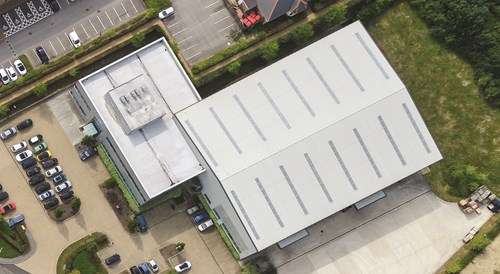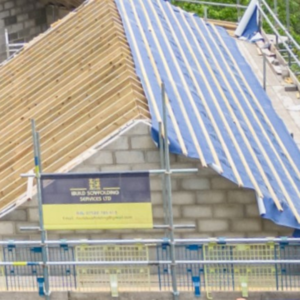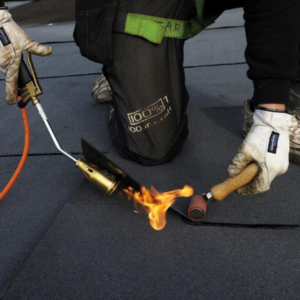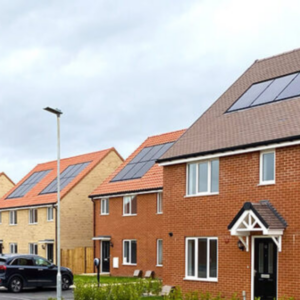Chris Pearce, safety representative for NARM, clears up some confusion surrounding the non-fragility of profiled rooflights and highlights their importance in improving energy efficiency.

Recent articles in the construction press have led to some confusion regarding the non-fragility of profiled rooflights. As the trade association representing the UK’s rooflight industry, NARM—National Association of Rooflight Manufacturers—has played a significant role in championing roof safety. So, what are the facts?
Way back in the early 1900s, industrial and commercial buildings were being roofed with new Asbestos Cement (AC) corrugated sheets. There was no requirement to make the sheets safe to walk on, and for clarity, they were made as ‘fragile’ roof sheets with instructions not to be walked on. In the 1950s translucent profiled rooflights were introduced that matched the corrugations of the AC sheets. They were also manufactured as ‘fragile’ sheets to match the surrounding roof.
It was not until the mid-1990s that the HSE stated that they wanted all roofing products to be manufactured to be ‘non-fragile’ when fixed. However, they did not define what was ‘non-fragile’. It was the rooflight industry that started discussions with the HSE to establish a universal test that could be carried out by manufacturers of roofing products that was deemed to provide a safe, non-fragile roof.
All trade bodies associated with the manufacture of roofs and their components formed an organisation called the Advisory Committee for Roofsafety (ACR). They took their lead from the HSE who specified the performance they required for a worker on the roof to stumble and fall onto the roof without falling through the roof.
We have no evidence from the HSE that anyone has died by falling through a rooflight that was built since year 2000.
A test rig was designed, with the full details of the test stated in the ACR ‘Red Book’ ACR (M)001 ‘Test for Non-Fragility of Large Element Roofing Assemblies’. From the year 2000 most UK industrial roofing has been designed to be non-fragile and it should be recognised that it was the UK rooflight industry that started this process.
It should also be recognised that most roofing components have been improved and not just the rooflights. Asbestos cement sheets have evolved and are now manufactured from Fibre Cement with reinforcement strips, metal profiled sheets and metal lining panels are made thicker (stronger) and profiled rooflights are now generally stronger and can be made as strong as the metal sheets.
The fixing and sealant specifications have been improved. Without any doubt, the majority of roofs designed and fitted today are designed to be non-fragile for many years. The roofing sector is saving lives and the statistics for deaths caused on new build bears this out.
One of the issues that follows this improvement in the design specification, is that today’s designers are seeking guarantees of non-fragility. It must be emphasised that the test for non-fragility is the testing of a roof system, not just one component. The system is affected by the number, type and installation of fixings; the lap sealant position; the strength of the roof sheets and lining panels—and the attention to detail by the roofer.
Manufacturers of roof sheeting will provide very clear fixing requirements, but they have no control over whether such instructions are followed. Failure to install any part of the roof correctly could mean that the roof is fragile as built.
Designers should also be aware that prevailing environmental conditions could have a medium-long term effect on the durable life of a roof structure. Buildings near the coast will be affected by the marine environment and similarly, buildings close to a chemical process could be affected by corrosive chemicals. All roofing materials will be affected by these environmental issues and will eventually become fragile. One of the advantages of UK-produced rooflights is that they are very resistant to chemical attack and different strength grades are available that can offer rooflights and opaque sheets to be longer lasting than their metal sheet equivalents.
A recent press article implied that even though we now have rooflight designs that are non-fragile, there are still deaths reported from workers walking on roofs and falling through roof-lights. This raises two important points that need consideration:
Well over 50% of the existing industrial and commercial building stock in the UK was built before year 2000. Such buildings were built as a fragile roof and now after a further 18 years will be much more fragile than when originally built. This is not going to change in the short term and indeed if roofers become complacent when working on roofs, there is a greater risk of falling through old roofs. Since the year 2000, we have no knowledge from the HSE that anyone has died by falling through a rooflight that was built since year 2000.
All roofs are potentially unsafe. They should be treated as fragile unless there is evidence to demonstrate non-fragility. No one should be allowed to go on to a roof without a full risk assessment and confirmation that those accessing the roof are fully trained and aware of the dangers and have the necessary safety procedures in place.
Benefits of designing buildings with rooflights
With the increasing demands of Building Regulations Part L since 2002, there is a growing awareness of the major part that rooflights play to save energy for the BER (Building Emission Rate).
To optimise the BER, rooflights should occupy 12% – 15% of the roof area, with the rooflights specified as triple skin. Additionally, electric lights must be automatically controlled to dim or switch off when satisfactory light levels are achieved with natural light. Automatic control of electric lights is an important requirement, since Part L BER calculations assume that without automatic control, the lights will be turned on in the early morning but never turned off during the day, so the benefit of the energy calculation by providing natural light via rooflights is not realised.
When designed and planned correctly, the energy savings from rooflights could therefore save up to 50% of the total energy demand needed to operate the building, and additionally the people inside the building have the ‘feel good factor’ from natural daylight. Rooflights are a ‘win—win’ for modern buildings.



